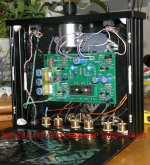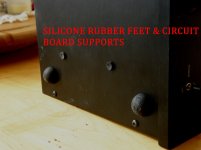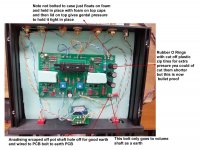Agreed. I believe my Zener is out of spec. I see 9.4v at T5/T6 after warmup. I ordered a pack of them to test them until I find one that is within spec.
The functional channel sits dead on at .7v during warmed up operation.
Thanks,
I debated putting a small thermistor (CL-130) in series with the 475 ohm resistor to further limit the startup current.
If you consider the circuit, the cathode resistance is almost one-tenth that of the current limiting resistor and that makes the startup surge minimal compared to a regular AC-driven tube heater with no inline resistor, that's why I abandoned the LM317 idea because the "surge" assuming a zero-ohm cold cathode is still only a few milliamps. I think that no further surge limiter is needed.
I see. Makes sense as to why it’s such a simple filament supply. I’ll work forward with what I ordered. Thanks
OK, color me OCD, but I have a question/proposal:
In order to set 17 mA for the cathodes and keep it steady requires 8.77 volts given the 475R resistors in the cathode circuit. How about replacing the 270R 3W resistor in the power supply with an LM317 and remove the zener? The zener location could be filled by additional capacitance if desired.
The current through the zener would be gone and looks like the bias circuits draw maybe 2 mA total, so total current would be around 35 mA? Seems like the 317 would drop around 500mW -- fine for a TO-220 without heatsink, maybe even a TO-92? The pre- and post-regulator caps are already in place so needs only the 317 and two low power resistors.
Just supposin' . . .
In order to set 17 mA for the cathodes and keep it steady requires 8.77 volts given the 475R resistors in the cathode circuit. How about replacing the 270R 3W resistor in the power supply with an LM317 and remove the zener? The zener location could be filled by additional capacitance if desired.
The current through the zener would be gone and looks like the bias circuits draw maybe 2 mA total, so total current would be around 35 mA? Seems like the 317 would drop around 500mW -- fine for a TO-220 without heatsink, maybe even a TO-92? The pre- and post-regulator caps are already in place so needs only the 317 and two low power resistors.
Just supposin' . . .
Awesome rebounding fellow do-it-yourselfers! You turned a potential negative into a positive which is no small feat given the nature of “texting” interpretations. I’m awed at how small the nuTube is and it’s capability & that its a really small cost comparatively speaking. The DIY store is just fabulous & I hope I live long enough to build more sound inspiring devices.
So, out of curiosity, I opened up both my B1K and my NuHybrid HPA to measure voltages. The B1K has the stock 9.1V zener/475 ohm filament supply and the HPA design has its stock 3.3V regulator/150 ohm filament supply. What is interesting are the voltage measurements, which were made after a 5 minute warmup.
B1K
F1 = 0.729V
F3 = 0.723V
actual 9.1V zener voltage = 9.59V
filament current (using 41 ohms as the hot filament resistance) 0.729/41 = 17.8 mA
NuHybrid HPA
F1 = 0.635V
F3 = 0.659V
actual 3.3V regulator voltage = 3.26V
filament current (using 41 ohms as the hot filament resistance) 0.659/41 = 16.1 mA
BTW, the 3.3V regulator does not have a heat sink and runs pretty hot to the touch since it's dropping from a 24V supply. Output voltage drops a few hundredths of a mV as it heats up.
So will running the lower filament current affect the sound of the B1K? A case could be made that part of the way a low voltage plate with a direct heater/cathode works is by leveraging the "space charge" effect. Higher filament current should theoretically yield a greater "space charge". But prior listening tests seem to indicate that this is not required for the NuTube.
I found back when I was comparing the B1K to the Millett NuTube Buffer preamp (same 3.3V/150 ohm filament supply as the NuHybrid HPA and same 475K plate resistors) that I could get it to sound just like the B1K when I changed Pete's 475K plate resistors to the 332K resistors used in the B1K. So apparantly the differences in the filament supply between the two designs is not as critical to sound character as the plate resistance.
My conclusion is since there appears to be no sonic penalty, to run lower filament current and hopefully get longer tube life as a result.
B1K
F1 = 0.729V
F3 = 0.723V
actual 9.1V zener voltage = 9.59V
filament current (using 41 ohms as the hot filament resistance) 0.729/41 = 17.8 mA
NuHybrid HPA
F1 = 0.635V
F3 = 0.659V
actual 3.3V regulator voltage = 3.26V
filament current (using 41 ohms as the hot filament resistance) 0.659/41 = 16.1 mA
BTW, the 3.3V regulator does not have a heat sink and runs pretty hot to the touch since it's dropping from a 24V supply. Output voltage drops a few hundredths of a mV as it heats up.
So will running the lower filament current affect the sound of the B1K? A case could be made that part of the way a low voltage plate with a direct heater/cathode works is by leveraging the "space charge" effect. Higher filament current should theoretically yield a greater "space charge". But prior listening tests seem to indicate that this is not required for the NuTube.
I found back when I was comparing the B1K to the Millett NuTube Buffer preamp (same 3.3V/150 ohm filament supply as the NuHybrid HPA and same 475K plate resistors) that I could get it to sound just like the B1K when I changed Pete's 475K plate resistors to the 332K resistors used in the B1K. So apparantly the differences in the filament supply between the two designs is not as critical to sound character as the plate resistance.
My conclusion is since there appears to be no sonic penalty, to run lower filament current and hopefully get longer tube life as a result.
AVDESIGNGURU,
I am compelled to ask a question since I see that you have built numerous projects by P. Millett, N. Pass, and John Broskie. Me too. The SP1 Korg Nutube has been a fascination for a few builds. I recently sold a B1 preamp to a customer who had a complaint about ringing, and so I simply refunded the money had him send it back. It arrived today, I plugged it in, and no ringing, let alone other noise. Have you ever had such an experience with a tube ringing, let alone have completely stop. I am at a stand still until I have some feedback from experienced builders such as yourself. Many thanks, Greg
I am compelled to ask a question since I see that you have built numerous projects by P. Millett, N. Pass, and John Broskie. Me too. The SP1 Korg Nutube has been a fascination for a few builds. I recently sold a B1 preamp to a customer who had a complaint about ringing, and so I simply refunded the money had him send it back. It arrived today, I plugged it in, and no ringing, let alone other noise. Have you ever had such an experience with a tube ringing, let alone have completely stop. I am at a stand still until I have some feedback from experienced builders such as yourself. Many thanks, Greg
Last edited:
@Ixnay:
NuTube ringing is typically from loudspeaker sound vibrating the tube, sometimes airborne, sometimes surface vibrations through the chassis. Playing loud music while the preamp sits somewhere close by a loudspeaker can be a problem. If the power amp input is low gain and the B1K cranked up to compensate, that would tend to make things worse. Just sitting there it probably won't ring but I did have one channel of a NuClassD amp spontaneously ring with no source playing. That one tube was my only real problem out of 5 tubes although my B1K tube "dinks" when tapped on or the power toggel switch is snapped. You can "dink" the left side for a left channel noise or the right side of the tube for a right channel noise but it's fine in normal use.
So, you probably are not duplicating the physical conditions of your customer. This forum has many posts addressing ringing and its potential solutions. I believe 6L6 uses a Prismacolor Magic Rub eraser taped to the top. Do a search.
NuTube ringing is typically from loudspeaker sound vibrating the tube, sometimes airborne, sometimes surface vibrations through the chassis. Playing loud music while the preamp sits somewhere close by a loudspeaker can be a problem. If the power amp input is low gain and the B1K cranked up to compensate, that would tend to make things worse. Just sitting there it probably won't ring but I did have one channel of a NuClassD amp spontaneously ring with no source playing. That one tube was my only real problem out of 5 tubes although my B1K tube "dinks" when tapped on or the power toggel switch is snapped. You can "dink" the left side for a left channel noise or the right side of the tube for a right channel noise but it's fine in normal use.
So, you probably are not duplicating the physical conditions of your customer. This forum has many posts addressing ringing and its potential solutions. I believe 6L6 uses a Prismacolor Magic Rub eraser taped to the top. Do a search.
Thanks for your input. Yes, after building P. Millett's 50w class D amp with the SP1, I also had a ringing issue. Then it just disappeared. The amp sounded way better than I thought it would.
I agree with the location/damping of the B1. I have done everything that I can think of to reduce the microphonic issue, and as stated, it does not present a problem when set up in my shop system, nor did it in my home system.
I agree with the location/damping of the B1. I have done everything that I can think of to reduce the microphonic issue, and as stated, it does not present a problem when set up in my shop system, nor did it in my home system.
Attachments
I put the fuzzy side of a piece of Velcro under the Nutube with the fuzz toward the bottom of the tube and slightly compressed. It seems to cushion very well. I've never had a problem with ringing and the wife loves to "crank it up" at times when she is in her office next to the listening room. I'm actually surprised it doesn't ring since after such a session she sometimes has to straighten the pictures on her office wall.
Thanks for your input. Yes, after building P. Millett's 50w class D amp with the SP1, I also had a ringing issue. Then it just disappeared. The amp sounded way better than I thought it would.
I agree with the location/damping of the B1. I have done everything that I can think of to reduce the microphonic issue, and as stated, it does not present a problem when set up in my shop system, nor did it in my home system.
Pete includes a small pot on the PCB he labels "gain". It's actually the negative feedback level for the channel. Slightly increasing the NFB (reducing the "gain") got rid of the ringing problem in my NuClassD amp.
In my experience the problem of ringing is very stiff. I built the Pass Nutube on January, and for a couple of months I could not understand what the microhopnic problem other people were talking of was. One night I forgot nutube and amp switched on and I was woke up by my wife: "what is this loud whistle coming from the living room?"
Still fighting with this random event.
renato
Still fighting with this random event.
renato
So, out of curiosity, I opened up both my B1K and my NuHybrid HPA to measure voltages. The B1K has the stock 9.1V zener/475 ohm filament supply and the HPA design has its stock 3.3V regulator/150 ohm filament supply. What is interesting are the voltage measurements, which were made after a 5 minute warmup.
So will running the lower filament current affect the sound of the B1K? A case could be made that part of the way a low voltage plate with a direct heater/cathode works is by leveraging the "space charge" effect. Higher filament current should theoretically yield a greater "space charge". But prior listening tests seem to indicate that this is not required for the NuTube.
I found back when I was comparing the B1K to the Millett NuTube Buffer preamp (same 3.3V/150 ohm filament supply as the NuHybrid HPA and same 475K plate resistors) that I could get it to sound just like the B1K when I changed Pete's 475K plate resistors to the 332K resistors used in the B1K. So apparantly the differences in the filament supply between the two designs is not as critical to sound character as the plate resistance.
My conclusion is since there appears to be no sonic penalty, to run lower filament current and hopefully get longer tube life as a result.
I agree with your conclusion. Given that zener voltages are +/- 5% and fixed-voltage regulators typically are not much better, I think the simplest way to achieve a desired current flow through the Korg cathodes is to measure the applied voltage and to replace the 475R resistors with a better-suited value based on the zener's actual voltage.
Then, what is an ideal current value, around 16.5mA? How low can you go without affecting the sound or another part of the circuit?
Last edited:
16 mA is a minimum, 20 mA is a maximum
17mA or 18mA are OK 🙂
T5, T6 test points on the pcb to ground mesure = 0.6 V normaly
http://www.nutube.us/downloads/Nutube_Datasheet_31.pdf
17mA or 18mA are OK 🙂
T5, T6 test points on the pcb to ground mesure = 0.6 V normaly
http://www.nutube.us/downloads/Nutube_Datasheet_31.pdf
16 mA is a minimum, 20 mA is a maximum
17mA or 18mA are OK 🙂
T5, T6 test points on the pcb to ground mesure = 0.6 V normaly
http://www.nutube.us/downloads/Nutube_Datasheet_31.pdf
Oh, great. Details in Korg's own published documents don't agree. However, they both agree that current can be as low as 16mA so I'm going with 16.5mA. My zener is under 9.0V (can't remember exactly) but I'm going to check it and change resistors if appropriate.
Nicely detailed spec sheet, though.
For any newbies to this thread, start with the simple Staedtler Mars white eraser on top of the "tube". These extreme measures are for extreme cases. The eraser worked perfectly for me on the ringing front.
Here is the 'what if' I am dealing with. This tube rings/oscillates even when there is no input! And as far as damping, I have already gone to the extreme to deal with it. The ringing stops for a time, so then I play music and it returns. I will simply replace the tube and hope that the warrantee is any good.
My B1K rarely rings, except briefly when flipping the input switch. However yesterday I added a CD player to my system and the B1K rang in a weird way when the B1K was on top of the CD player. I moved the B1K down to near my ACA and the ringing went away. I suspect EMF might influence ringing.
While EMF may affect ringing, in ranshadow's particular case it MAY be vibration for the CD player generated as a result of the CD spinning. It may be difficult to demonstrate, however, as any shielding inserted between the CD player and the B1K may also act to dampen vibrations.
While EMF may affect ringing, in ranshadow's particular case it MAY be vibration for the CD player generated as a result of the CD spinning. It may be difficult to demonstrate, however, as any shielding inserted between the CD player and the B1K may also act to dampen vibrations.
I was getting a high pitched whine out of my B1K every once in a while when it was sitting on top of my metal cased (unused) preamp. My B1K unit has soft rubber feet and the white magic rub eraser on top of the Nutube. I cut a piece of small bubble bubble-wrap and put it under the unit & haven’t had the whine since. It could be vibrations from the CD spinning, yes, or maybe vibrations (on a metal casing) from music being played cab cause ringing?
BTW, I even have the magnet mounted behind the Nutube replicating the report by the Japanese builder. Ringing can still occur (banging on the B1K case) but it sounds more like a quick metal "TING" than an extended ring. The whine I mentioned earlier lasted a long time and only disappeared after I turned the B1K off and on.
Cheers
- Home
- Amplifiers
- Pass Labs
- B1 with Korg Triode


